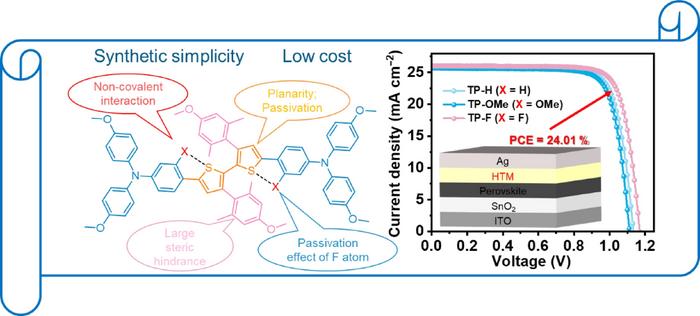A team of Chinese researchers has developed innovative materials that could make solar energy more affordable and efficient. Their work focuses on improving perovskite solar cells, a promising technology hampered by expensive components. The new materials, called hole transport materials (HTMs), play a crucial role in moving electrical charges within the solar cell.
The Science Behind the Innovation
The researchers created three new HTMs based on a bithiophene core structure. These materials, named TP-H, TP-OMe, and TP-F, were designed to improve how molecules pack together and dissolve. These properties are vital for effectively moving electrical charges in solar cells.
The standout performer was TP-F, which contains fluorine atoms. This material helped solar cells convert light into electricity with over 24% efficiency. That’s a significant improvement over existing technologies.
Dr. Wei Gao, who led the study, explained: “The development of these novel HTMs marks a significant step towards making PSCs more commercially viable. The enhanced efficiency and reduced costs of these materials could accelerate the adoption of PSCs in the solar energy market, providing a more sustainable and cost-effective energy solution.”
Why It Matters
This research could make solar power more accessible and affordable. By reducing the cost of key components while maintaining high performance, these new materials address a major barrier to widespread solar adoption. As the world seeks to reduce reliance on fossil fuels, innovations like this are crucial for transitioning to cleaner energy sources.
The new HTMs offer several advantages over current materials:
- Simpler production process
- Lower manufacturing costs
- Improved efficiency in converting sunlight to electricity
- Better molecular packing for enhanced charge transport
These improvements could lead to solar panels that are both more efficient and less expensive to produce. This combination is essential for making solar energy competitive with traditional power sources on a large scale.
The research team’s work builds on previous efforts to improve perovskite solar cells. While earlier studies have focused on the perovskite material itself, this approach tackles the often-overlooked but critical hole transport layer. By optimizing this component, the researchers have unlocked new levels of performance.
Looking ahead, the successful integration of TP-F into working solar cells demonstrates the potential for real-world applications. The next steps will likely involve scaling up production and testing the long-term stability of devices using these new materials. If successful, we could see these innovations incorporated into commercial solar panels in the coming years.
As solar technology continues to advance, breakthroughs like this bring us closer to a future where clean, renewable energy is the norm rather than the exception. With continued research and development, perovskite solar cells may soon rival or surpass traditional silicon-based panels in both performance and cost-effectiveness.
If our reporting has informed or inspired you, please consider making a donation. Every contribution, no matter the size, empowers us to continue delivering accurate, engaging, and trustworthy science and medical news. Independent journalism requires time, effort, and resources—your support ensures we can keep uncovering the stories that matter most to you.
Join us in making knowledge accessible and impactful. Thank you for standing with us!

